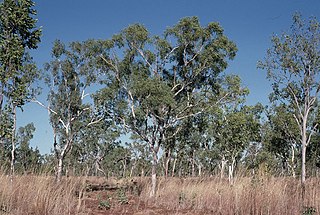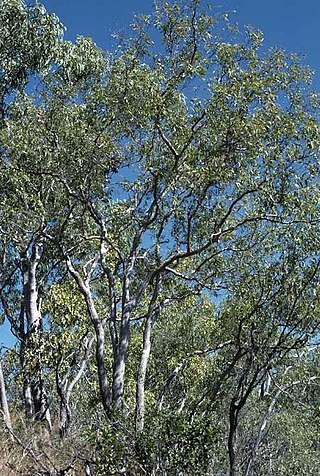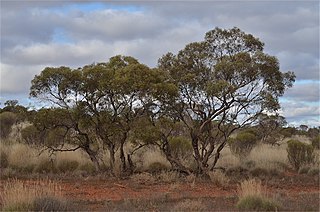
Eucalyptus caliginosa, commonly known as broad-leaved stringybark or New England stringybark, is a tree that is endemic to eastern Australia. It has stringy bark, lance-shaped or curved adult leaves, flower buds in groups of seven or nine, white flowers and more or less hemispherical fruit. It is common on the Northern Tablelands and North West Slopes of New South Wales and adjacent areas of Queensland.

Eucalyptus cephalocarpa, commonly known as mealy stringybark or silver stringybark is a species of small to medium-sized tree, that is endemic to south-eastern Australia. It has rough, fibrous bark on the trunk and branches, lance-shaped adult leaves, Flower buds arranged in groups of seven, white flowers and conical, bell-shaped or hemispherical fruit.

Eucalyptus agglomerata, commonly known as blue-leaved stringybark, is a tree endemic to eastern Australia. It has persistent, stringy bark, green or greyish leaves with a bluish sheen, flower buds in groups of eleven to fifteen, white to cream-coloured flowers and crowded, flattened hemispherical fruit.

Eucalyptus laevopinea, commonly known as the silver top stringybark, is a tree that is endemic to eastern Australia. It has rough, stringy greyish bark on the trunk and larger branches, glossy green, lance-shaped adult leaves, flower buds in groups of between seven and eleven, white flowers and hemispherical or shortened spherical fruit.

Eucalyptus tenella, commonly known as narrow-leaved stringybark, is a species of small to medium-sized tree that is endemic to New South Wales. It has stringy bark, narrow lance-shaped to linear leaves, flower buds in group of seven to fifteen, white flowers and hemispherical fruit.

Eucalyptus cameronii, commonly known as the diehard stringybark is a flowering plant that is endemic to eastern Australia. It is a small to medium-sized tree with rough, stringy bark from the trunk to the small branches, lance-shaped to curved adult leaves, flowers buds in groups of between nine and fifteen, white flowers and cup-shaped, hemispherical or more or less spherical fruit. It mainly grows on the eastern side of the Northern Tablelands in New South Wales.

Eucalyptus baileyana, commonly known as Bailey's stringybark, is a tree endemic to near-coastal areas of eastern Australia. It has rough, stringy bark on its trunk and main branches, lance-shaped adult leaves, flower buds in groups of seven, white flowers with stamens in four bundles and urn-shaped to more or less spherical fruit.

Eucalyptus boliviana, commonly known as Bolivia Hill stringybark or Bolivia stringybark is a shrub or a mallee, sometimes a small tree and is endemic to a small area in northern New South Wales. It is a stringybark with four-sides stems, broadly lance-shaped adult leaves, flower buds arranged in groups of seven, yellow flowers and hemispherical to broadly funnel-shaped fruit.

Eucalyptus mckieana, commonly known as McKie's stringybark, is a species of tree that is endemic to New South Wales. It has rough, stringy bark on the trunk and branches, lance-shaped to curved adult leaves, flower buds in groups of between seven and eleven, white flowers and cup-shaped, barrel-shaped or hemispherical fruit.

Eucalyptus tectifica, commonly known as Darwin box, or grey box, is a species of tree that is endemic to northern Australia. It has rough, fibrous or flaky bark on the trunk and branches, lance-shaped or curved adult leaves, flower buds usually in groups of seven, creamy white flowers and conical, cup-shaped or barrel-shaped fruit.
Eucalyptus xerothermica is a species of mallee or a tree that is endemic to northern Western Australia. It has rough, fibrous or flaky bark on the trunk and branches, lance-shaped to curved adult leaves, flower buds in groups of three or seven, creamy white flowers and conical to barrel-shaped fruit.

Corymbia jacobsiana, commonly known as Jacob's bloodwood or stringybark bloodwood, is a species of tree that is endemic to the Northern Territory. It has rough, stringy bark on the trunk and branches, lance-shaped to elliptical or curved adult leaves, flower buds in groups of three or seven, creamy white flowers and urn-shaped fruit.

Eucalyptus conglomerata, commonly known as the swamp stringybark, is a species of straggly tree or mallee that is endemic to Queensland. It has rough, fibrous "stringybark" lance-shaped to oblong adult leaves, flower buds in groups of eleven or more, white flowers and more or less barrel-shaped fruit.
Eucalyptus latisinensis, commonly known as white mahogany, is a species of tree that is endemic to Queensland. It has rough, fibrous to stringy bark, lance-shaped to curved adult leaves, flower buds in groups of seven to eleven or more, white flowers and shortened spherical to hemispherical fruit.

Eucalyptus sphaerocarpa, commonly known as the Blackdown stringybark, is a species of tall forest tree that is endemic to Queensland. It has rough, stringy bark on the trunk and branches, lance-shaped to curved adult leaves, flower buds in groups of seven, nine or eleven, white flowers and shortened spherical fruit.
Eucalyptus erosa is a species of tree that is endemic to a small area of Queensland. It has rough, fibrous to stringy grey bark, lance-shaped to curved adult leaves, flower buds arranged in groups of between nine and thirteen, white flowers and cup-shaped to hemispherical fruit.
Eucalyptus longissima is a species of mallee or small tree that is endemic to the south-west of Western Australia. It has rough, fibrous or stringy bark on the trunk, smooth greyish brown bark above, glossy green, lance-shaped adult leaves, flower buds in group of between seven and thirteen, white flowers and shortened spherical fruit.
Eucalyptus megasepala is a species of medium-sized tree that is endemic to Far North Queensland and Cape York Peninsula. It has rough, fibrous or stringy bark from the trunk to the smaller branches, lance-shaped or curved adult leaves, flower buds in groups of three, white flowers and cup-shaped to cylindrical fruit.

Eucalyptus socialis subsp. eucentrica, commonly known as the inland red mallee, is a subspecies of mallee that is endemic to inland Australia. It usually has rough bark on the base of the trunk, smooth bark above, lance-shaped adult leaves, flower buds in groups of between seven and eleven, pale creamy yellow flowers and barrel-shaped to urn-shaped or spherical fruit.

Eucalyptus socialis subsp. socialis, commonly known as the summer red mallee, is a subspecies of mallee that is endemic to inland south-eastern Australia. It usually has rough bark on the base of the trunk, smooth bark above, lance-shaped adult leaves, flower buds in groups of between seven and eleven, pale creamy white flowers and barrel-shaped to urn-shaped or spherical fruit.
















